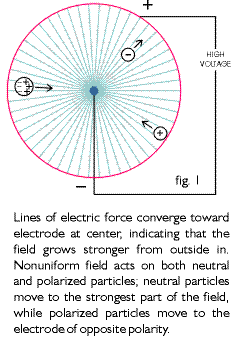ELECTRON CASCADE EFFECT
Taken from Patrick Flanaganís taped lecture on The Electron Field
Generator (c.1988). The electron cascade is a phenomenon of continuous
production of electrons - throughout the environment in the air itself.
The production of the electron cascade effect, according to Patrick
is...
 "Number one, we have this phenomenon whereby we found that
certain insulators, and some insulators are more effective than others, if
we apply a high frequency, high voltage, alternating field across an
insulator that we produce this [J.Willard] Gibbs phenomenon, this
non-Maxwellian field, which has a differential polarization, that is, that
it creates a polarity differential between it and the environment such
that neutral and charged air molecules are accelerated at extremely high
speed, not very low speed, but at very high speed toward the emitter. As
these molecules are accelerated they collide with other molecules in the
air and when this collision occurs the electrons are knocked off the
molecules, that is, free electrons are knocked off the molecules and they
in turn are accelerated by this field and then collide with the other
the basis of what we call the electron cascade - we have an entire cascade
of electrons being generated everywhere in the environment.
"Number one, we have this phenomenon whereby we found that
certain insulators, and some insulators are more effective than others, if
we apply a high frequency, high voltage, alternating field across an
insulator that we produce this [J.Willard] Gibbs phenomenon, this
non-Maxwellian field, which has a differential polarization, that is, that
it creates a polarity differential between it and the environment such
that neutral and charged air molecules are accelerated at extremely high
speed, not very low speed, but at very high speed toward the emitter. As
these molecules are accelerated they collide with other molecules in the
air and when this collision occurs the electrons are knocked off the
molecules, that is, free electrons are knocked off the molecules and they
in turn are accelerated by this field and then collide with the other
the basis of what we call the electron cascade - we have an entire cascade
of electrons being generated everywhere in the environment.
 Now its true that we have a greater, that is, higher
velocity, electrons being generated in the vicinity of the machine,
however, so that the air passing through the machine (we have a fan that
brings air through the machine, through this emitter device), although the
air passing through the machine is exposed to very high concentration of
free electrons the machine is also creating free electrons in space around
the machine, that is, so that, it is affecting air and purifying air in
the environment."
Now its true that we have a greater, that is, higher
velocity, electrons being generated in the vicinity of the machine,
however, so that the air passing through the machine (we have a fan that
brings air through the machine, through this emitter device), although the
air passing through the machine is exposed to very high concentration of
free electrons the machine is also creating free electrons in space around
the machine, that is, so that, it is affecting air and purifying air in
the environment."

The standard negative-ion ionizer charges only a very
LOCAL area of air, of about one metre from the unit (directly outside of
which is strongly positively charged); whereas the superior
electron cascade effect creates free-electrons actually in the
environment by speeding up electrons, which in turn collide with air
atoms, to create more free-electrons. The force of the free-electrons is
then enhanced by dielectrophoresis and electrophoresis acting in a
nonuniform electric field, resulting in a cooled environment of fresh
negative-ion air.
See his US patents 4,391,773 (July 5 1983), and 4,743,275 (May 10 1988)
The Electron
Field Generator.



